AAC Assessment Corner by Vicki Clarke: Procedural Resources
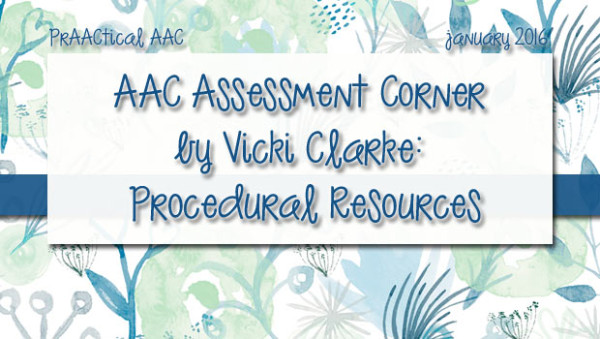
The new year is bringing some changes to PrAACtical AAC, and one that I am most excited about is a regular monthly article by SLP Vicki Clarke. Vicki is a phenomenal 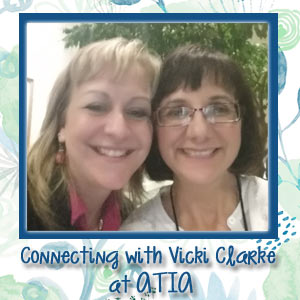 clinician with a private practice in Georgia who has been specializing in AAC since 1991. Her practice, Dynamic Therapy Associates, averages around 50 AAC evaluations a year, so she was the perfect choice to write about AAC assessment practices. Vicki’s assessments are for both for individuals and school districts, and include clients of all ages (peds through adults) who have a variety of challenges and etiologies (e.g., motor disorders, memory, attention and learning difficulties, sensory impairment, neurological differences, syndromes and seizure disorders, congenital and acquired difficulties). Click on these links to learn more about Vicki’s life as an AAC therapist and the kinds of supports provided at Dynamic Therapy Associates. I know you will appreciate the resources, ideas, and tips that Vicki plans to share in this series. Enjoy!
clinician with a private practice in Georgia who has been specializing in AAC since 1991. Her practice, Dynamic Therapy Associates, averages around 50 AAC evaluations a year, so she was the perfect choice to write about AAC assessment practices. Vicki’s assessments are for both for individuals and school districts, and include clients of all ages (peds through adults) who have a variety of challenges and etiologies (e.g., motor disorders, memory, attention and learning difficulties, sensory impairment, neurological differences, syndromes and seizure disorders, congenital and acquired difficulties). Click on these links to learn more about Vicki’s life as an AAC therapist and the kinds of supports provided at Dynamic Therapy Associates. I know you will appreciate the resources, ideas, and tips that Vicki plans to share in this series. Enjoy!
Kicking Off the AAC Assessment Series
I’m a big picture person. I like to know what my end goal is and the systematic journey to get there. This is an unfortunate fact for a person obsessed with AAC, a field with brilliant solutions to specific and dissimilar individual communication difficulties. As a specialization, we have some of the most creative and driven professionals I have ever met. We are truly a profession of problem solvers. The challenge we face is working to solve a similar problem, complex communication needs, for a dissimilar population of people. Our patients come to us with a myriad of challenges which can include motor speech disorders, language impairments, sensory needs, Autism, memory and processing challenges. As a result of troubleshooting for this heterogenous group, we have a wide variety of unique solutions and no ONE 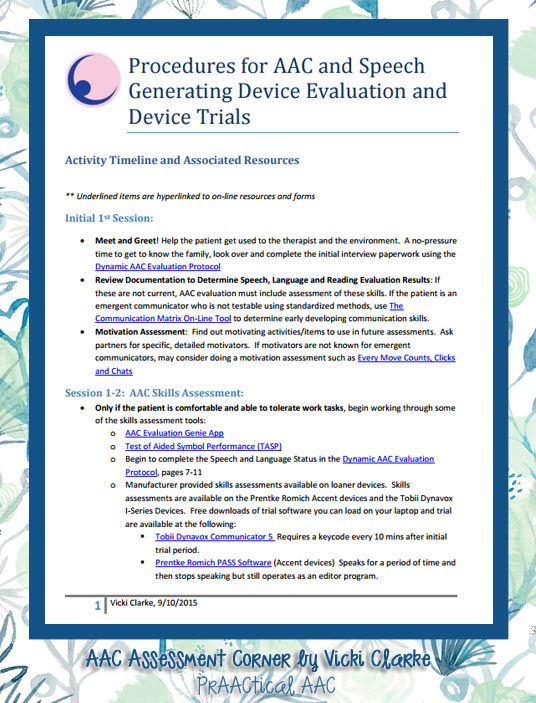 answer to the singular problem of complex communication needs. So now what?
answer to the singular problem of complex communication needs. So now what?
For me the answer is to watch, listen, think and compare what I’m seeing with the multitudes of other people with complex communication needs I’ve met. I try to find patterns of behaviors and positive responses to intervention in all of those former patients so that I can find similar solutions for my new patient. But what do we look for? What questions do we ask? What behaviors are we assessing? The answer to these questions is the impetus for this series of articles on AAC Assessment.
We’ll start this series by sharing a basic AAC evaluation procedures manual I developed. These procedures help organize my evaluations to fund speech generating devices for students and patients in our practice. The Procedures Manual and Protocol were developed after 25 years of conducting AAC evaluations and assisting in funding speech generating devices for patients of all ages and diagnoses.
There are 2 complete documents available for download by clicking these links, Dynamic AAC Evaluation Procedures Manual (6 pages) and Dynamic AAC Evaluation Protocol (27 pages).
The Dynamic AAC Evaluation Procedures Manual outlines the 7 steps to complete a successful AAC evaluation. This manual describes our process from the initial phone call from the family to the delivery of devices. Included in the outline are hyperlinks to online evaluation tools, funding document generators and editor versions of popular speech generating devices. 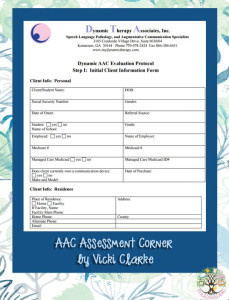 The Procedures Manual gives tips for setting up your evaluations to support families and gather important information for funding devices.
The Procedures Manual gives tips for setting up your evaluations to support families and gather important information for funding devices.
The Dynamic AAC Evaluation Protocol is a 27 page protocol which is designed to ensure you gather all the necessary demographics; sensory, cognitive, language, speech and motor information; AAC assessment trial details and; discuss important features for decision making. This document was particularly designed to ensure that you have all the required information to have a speech generating device funded by insurance and Medicaid/Medicare. Although successful funding cannot be guaranteed, all details required by funding sources are considered in the protocol.
Thank you for joining me in this on-going discussion of AAC evaluations. I am interested in your feedback, resources and suggestions as we work together to find better solutions for our friends with complex communication needs. I am excited to be joining PrAACtical AAC for this new venture in the new year!
Filed under: PrAACtical Thinking
Tagged With: assessment, download, resources
This post was written by Carole Zangari

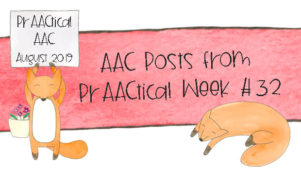

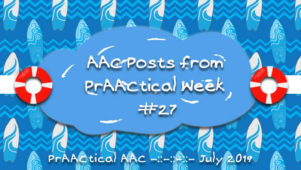
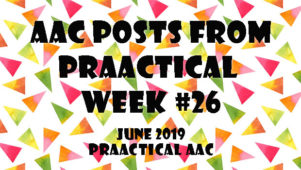
8 Comments
This is an awesome resource. I love it! Thank you so much.
Thank you so much for sharing these fantastic resources!
I noticed that you are not evaluating the student’s ability to use Proloquo2Go on the ipad which is preferred by many school districts because of its cost.
Is there are a reason for this?
Hi Jill, we definitely consider the iPad and the different comprehensive AAC available on it. The iPad is just like the other solutions we consider including dedicated devices and light tech solutions.
Wow! As a new clinician this is very helpful! !! Thank you for helping me to better help my students!!
You’re so welcome! Good luck with your evals!
What a great resource for all you are Vicki!
Thank you! I’m glad the resources are helpful!!